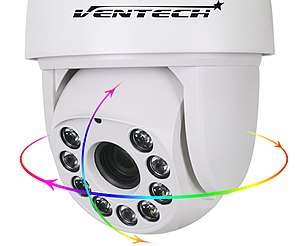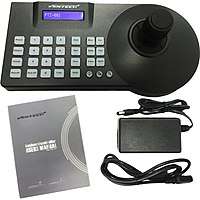Pan–tilt–zoom camera

A pan–tilt–zoom camera (PTZ camera) is a camera that is capable of remote directional and zoom control.
In television production, PTZ controls are used with professional video cameras in television studios, sporting events, and other spaces. They are commonly referred to as robos, an abbreviation of robotic camera. These systems can be remotely controlled by automation systems. The PTZ controls are generally sold separately without the cameras, but can also be sold as a set, as in the case of Fletcher cameras.[1]

PTZ is an abbreviation for pan, tilt and zoom and reflects the movement options of the camera. Other types of cameras are ePTZ or virtual pan-tilt-zoom (VPTZ) where a high-resolution camera digitally zooms and pans into portions of the image, with no physical camera movement. Ultra-low bandwidth surveillance streaming technologies use VPTZ to stream user-defined areas in higher quality without increasing overall bandwidth usage. Surveillance cameras of this type are often connected to a digital video recorder which records the full field of view in full quality.
PTZ Cameras are commonly used in applications such as surveillance, video conferencing, live production, lecture capture and distance learning.
Auto tracking
An innovation to the PTZ camera is a built-in firmware program that monitors the change of pixels generated by the video clip in the camera. When the pixels change due to movement within the camera's field of view, the camera can actually focus on the pixel variation and move the camera in an attempt to center the pixel fluctuation on the video chip. This results in the camera following movement. The program allows the camera to estimate the size of the object which is moving and distance of the movement from the camera. With this estimate, the camera can adjust the camera's optical lens, zooming in and out, in an attempt to stabilize the size of pixel fluctuation as a percentage of total viewing area. Once the movement exits the camera's field of view, the camera returns to a pre-programmed or "parked" position until it senses pixel variation and the process starts over again.
Video surveillance
Pan-tilt-zoom cameras can be an essential part of modern surveillance systems. They can direct the attention to suspicious events. One method of surveillance with such cameras is based on master cameras monitoring a wide area that provide information so the PTZ camera can pan and tilt to the required position and observe and/or follow target movements.[2]
See also
| Wikimedia Commons has media related to Pan–tilt–zoom camera. |
References
- ↑ http://www.sportsvideo.org/2015/05/12/svg-sit-down-fletcher-sports-grainge-talks-new-facility-growth-of-high-speed-camera-market/
- ↑ A. Del Bimbo, F. Dini, F. Pernici Multi-Camera Networks, Principles and Applications, Academic Press, Florence, 2009, p. 189-211